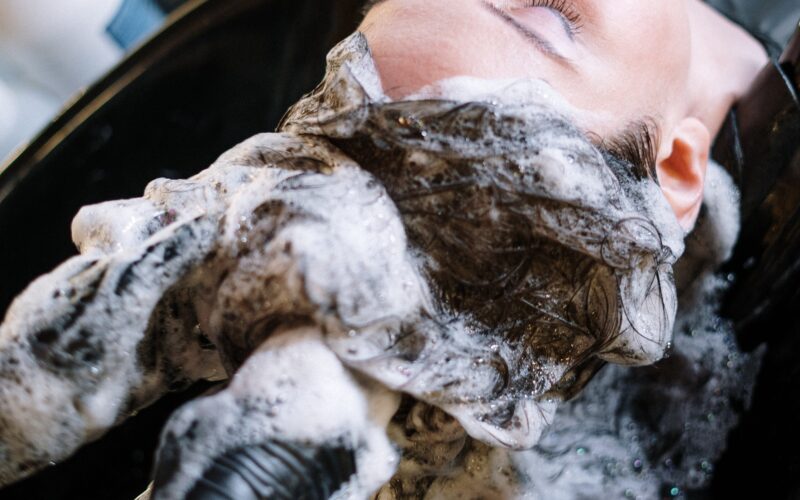The quest for thicker, healthier hair is a goal shared by many. It’s not just about looking good; it’s about feeling confident and empowered by your locks. Yet, with the vast array of thickening shampoos available on the market, choosing the right one for your hair type and goals can be a daunting task.
In this comprehensive guide, we’ll take you on a journey to unlock the secrets of achieving the hair you’ve always dreamed of. We’ll explore the world of hair thickening shampoos, their science, and the power they hold in transforming your locks. Additionally, we’ll delve into the synergy of using a hair thickening shampoo and conditioner duo for thinning hair and provide insights into managing oily hair and caring for low porosity hair.
By the end of this journey, you’ll be armed with the knowledge and confidence to select the perfect thickening shampoo for your hair type and address specific hair concerns. Let’s embark on this hair care adventure together, as we empower you to make informed choices for your tresses.
Which Hair Thickening Shampoo is Right for You?
When it comes to choosing the right hair thickening shampoo, it’s essential to consider several factors to ensure you’re getting the best product for your specific needs and hair type. Let’s dive into the key considerations:
1. Hair Type: The first step is to identify your hair type. Is it straight, curly, wavy, or somewhere in between? Different hair types have varying needs when it comes to thickening shampoo. For instance, curly hair often requires more hydration, while straight hair may benefit from volumizing formulas.
2. Hair Goals: What are your hair goals? Do you want to increase volume, reduce frizz, or combat hair loss? Understanding your objectives will help you narrow down your options. Look for thickening shampoos that explicitly target your desired outcome.
3. Ingredients: Take a close look at the ingredients list. Some key ingredients to watch for in hair thickening shampoos include biotin, caffeine, keratin, and vitamins like B7 and E. These ingredients can help strengthen and nourish your hair, promoting thickness and vitality.
4. Sulfate-Free Formula: Sulfates are detergents commonly found in shampoos. While they effectively clean the hair, they can also strip away natural oils and moisture. Opting for a sulfate-free formula can help maintain your hair’s health and prevent it from becoming overly dry.
5. Reviews and Recommendations: Don’t underestimate the power of reviews and recommendations from others who have similar hair types and goals. Reading reviews and seeking advice from friends or hair professionals can provide valuable insights into which products work best.
Benefits of Using Hair Thickening Shampoos
Choosing the right hair thickening shampoo can yield several benefits:
– Increased Volume: Hair thickening shampoos can help lift your hair at the roots, providing an immediate boost in volume and fullness.
– Strength and Resilience: Many of these thickening shampoos are formulated with ingredients that strengthen hair strands, reducing breakage and promoting overall hair health.
– Improved Texture: You’ll notice that your hair feels softer, smoother, and more manageable, making styling a breeze.
– Confidence Boost: Thicker, healthier hair can boost your confidence and make you feel more empowered in your daily life.
As you embark on your quest for the perfect hair thickening shampoo, keep these factors in mind to make an informed decision. Remember that everyone’s hair is unique, so what works for one person may not work for another. Experimentation may be necessary to find the product that gives you the best results.
How Hair Thickening Shampoos Work
You’ve decided to take the plunge and invest in a hair thickening shampoo, but have you ever wondered how these magical elixirs actually work? Let’s dive into the science behind these products and discover the secrets to achieving that luscious, voluminous mane.
1. DHT Blockers: One of the primary culprits behind hair loss is a hormone called dihydrotestosterone (DHT). DHT can shrink hair follicles, leading to thinner hair and eventual hair loss. Many hair thickening shampoos contain DHT-blocking ingredients like saw palmetto and ketoconazole. These compounds help inhibit the production of DHT, allowing hair follicles to thrive and produce thicker strands.
2. Follicle Stimulation: A healthy scalp is the foundation of strong, thick hair. Hair thickening shampoos often include ingredients like caffeine and niacin, which stimulate blood flow to the scalp. Improved blood circulation ensures that hair follicles receive the necessary nutrients and oxygen to grow and maintain healthy hair.
3. Strengthening Ingredients: To achieve that coveted thickness, hair strands need to be strong and resilient. Many thickening shampoos incorporate proteins like keratin, biotin, and collagen. These ingredients work to fortify the hair shaft, reducing breakage and promoting thicker, more robust hair.
4. Volumizing Agents: Some hair thickening shampoos contain volumizing agents that coat the hair strands, increasing their diameter. This added thickness gives the appearance of fuller hair.
5. Moisturization: Dry, brittle hair can appear flat and lifeless. To combat this, many shampoos also include hydrating ingredients like aloe vera, shea butter, and essential oils. Proper moisturization not only improves hair texture but also enhances volume and shine.
Key Ingredients to Look For
As you peruse the shelves for the perfect hair thickening shampoo, keep an eye out for these key ingredients:
– Biotin: Also known as vitamin B7, biotin helps strengthen hair and promote its growth.
– Caffeine: Stimulates the hair follicles and encourages hair growth.
– Keratin: A protein that strengthens and repairs damaged hair.
– Saw Palmetto: A natural DHT blocker that can slow down hair loss.
– Niacin (Vitamin B3): Improves blood circulation to the scalp, promoting hair growth.
– Collagen: Enhances hair thickness and elasticity.
By understanding how these ingredients work together, you can make an informed choice when selecting a hair thickening shampoo that aligns with your hair goals. It’s essential to give your chosen shampoo time to work its magic, as results may vary from person to person.
In the following section, we’ll explore the dynamic duo of hair care: shampoo and conditioner for thinning hair, and how they work together to amplify the benefits.
The Power of a Hair Shampoo and Conditioner Duo for Thinning Hair
While a quality hair thickening shampoo can work wonders on its own, combining it with a complementary conditioner designed for thinning hair can take your hair care routine to the next level. Let’s unravel the benefits of this dynamic duo and understand how they work in harmony to promote thicker, healthier locks.
1. Cleansing and Nourishing: Shampoo and conditioner each have a unique role in your hair care routine. Shampoo cleanses the hair and scalp, removing dirt, excess oil, and product buildup. On the other hand, conditioner nourishes and moisturizes the hair, making it softer, smoother, and more manageable.
2. Enhanced Volume: When you use a hair thickening shampoo followed by a conditioner, you’re providing a one-two punch for volume. The shampoo lifts and adds body to your hair at the roots, while the conditioner ensures your locks remain silky and free from tangles. This combination creates a voluminous, fuller appearance.
3. Strengthening and Protection: Hair thinning is often accompanied by increased fragility. The conditioner, enriched with strengthening ingredients like keratin and biotin, fortifies the hair shaft, reducing breakage and promoting overall hair health. Additionally, it forms a protective barrier, shielding your hair from external stressors and damage.
4. Long-Term Results: Consistency is key in achieving long-lasting results. Using a hair shampoo and conditioner duo designed for thinning hair regularly can lead to cumulative improvements. Over time, your hair may become thicker, more resilient, and less prone to breakage.
5. Customization: Many hair care brands offer shampoo and conditioner combinations tailored to specific hair types and concerns. Whether you have fine, curly, or color-treated hair, you can find a duo that addresses your unique needs.
How to Use the Duo Effectively
To reap the full benefits of a hair shampoo and conditioner duo for thinning hair, follow these steps:
1. Shampoo First: Start with the hair thickening shampoo. Apply it to wet hair, focusing on the roots and scalp. Massage gently to create a lather, then rinse thoroughly.
2. Condition Second: After shampooing, apply the conditioner to the lengths and ends of your hair. Leave it on for a few minutes to allow it to work its magic. Rinse with cool water to seal the hair cuticles and lock in moisture.
3. Consistency Is Key: For best results, use the duo regularly as part of your hair care routine. Most shampoos and conditioners recommend daily or alternate-day use.
By incorporating a hair shampoo and conditioner duo into your hair care regimen, you can achieve thicker, healthier hair that exudes vitality and confidence. In the next section, we’ll shift our focus to addressing the unique challenges of managing oily hair and choosing the right shampoo to keep it in check.
Managing Oily Hair: Choosing the Right Shampoo
Oily hair can be a persistent challenge, leaving you feeling like you need a fresh wash every few hours. Fortunately, selecting the appropriate shampoo and adopting the right hair care routine can help you manage excess oil and maintain the health of your hair. Let’s explore how to effectively address oily hair and choose the right shampoo for this specific concern.
Selecting the Appropriate Shampoo:
Choosing the right shampoo for oily hair is crucial in managing excess oil production. Look for these key features when selecting a shampoo:
1. Clarifying Shampoo: Opt for a clarifying shampoo designed to remove excess oil and residue. These shampoos typically contain ingredients like salicylic acid or tea tree oil, which help break down oil buildup on the scalp.
2. Balancing Formulas: Some shampoos are formulated specifically to balance oil production. These shampoos often contain natural extracts like aloe vera or chamomile, which can help regulate oil levels while maintaining hair’s natural moisture.
3. Sulfate-Free: Consider sulfate-free options. While sulfate shampoos are effective at removing oil, they can be harsh and strip your hair of essential moisture. Sulfate-free alternatives clean without over-drying.
4. Gentle Cleansing: Avoid using shampoos that are too harsh, as they can trigger the scalp to produce even more oil to compensate. Look for shampoos that offer gentle cleansing and are suitable for daily use.
Effective Oily Hair Management:
In addition to choosing the right shampoo, here are some effective strategies to manage oily hair:
1.Proper Washing Technique: When washing your hair, focus on massaging the shampoo into the scalp. This helps remove excess oil and prevents it from accumulating at the roots.
2. Rinse Thoroughly: Make sure to rinse your hair thoroughly to remove all shampoo and conditioner residue, which can contribute to oiliness.
3. Avoid Overwashing: While it may be tempting to wash oily hair frequently, overwashing can actually exacerbate the issue. Washing too often can strip your scalp of natural oils, leading to increased oil production. Aim for washing every 2-3 days or as needed.
4. Use Dry Shampoo: On non-wash days, dry shampoo can be your best friend. It helps absorb excess oil, leaving your hair looking fresh and clean.
5. Balanced Diet and Hydration: A balanced diet and proper hydration can also play a role in managing oily hair. Eating nutrient-rich foods and drinking enough water can contribute to overall hair health.
Remember that finding the right shampoo and hair care routine for oily hair may require some experimentation. Everyone’s scalp is unique, so what works for one person may not work for another. By following these tips and selecting the appropriate shampoo, you can effectively manage excess oil and maintain the health and beauty of your hair.
In the following section, we’ll shift our focus to a specific hair type: low porosity hair. We’ll explore what makes it unique and discuss the best shampoos and practices for caring for this type of hair.
Hair Shampoo for Low Porosity Hair: What You Need to Know
Low porosity hair is a unique hair type with distinct characteristics and needs. Understanding how to care for and choose the right shampoo for low porosity hair can make a significant difference in maintaining its health and appearance. Let’s dive into what low porosity hair is, its specific requirements, and the best shampoos to enhance its beauty.
Understanding Low Porosity Hair:
Low porosity hair refers to hair with tightly sealed cuticles, which resist moisture absorption. This means that low porosity hair often repels water and product buildup, making it prone to dryness and product residue.
Unique Characteristics of Low Porosity Hair:
– Water-Repellent: Water tends to bead up on low porosity hair, making it challenging to wet during washing.
– Product Buildup: The tight cuticle structure can lead to product buildup, causing hair to appear dull and lifeless.
– Slow Drying: Low porosity hair may take longer to dry, as moisture struggles to penetrate the hair shaft.
Choosing the Right Shampoo:
When selecting a shampoo for low porosity hair, consider the following factors:
1. Clarifying Shampoo: Opt for a clarifying shampoo to remove product buildup and open up the hair cuticles. These shampoos help prevent residue from accumulating, keeping your hair looking fresh.
2. Moisturizing Formulas: Look for shampoos with moisturizing ingredients like glycerin, honey, or aloe vera. These ingredients can help provide the much-needed hydration for low porosity hair.
3. pH-Balanced: pH-balanced shampoos are gentle on the hair and help maintain the natural pH of low porosity hair, preventing excessive dryness.
4. Sulfate-Free: As with other hair types, sulfate-free shampoos are a good option to avoid over-drying the hair.
5. Regular Use: It’s essential to wash low porosity hair regularly but not excessively. Keeping your hair clean can prevent product buildup, but washing too frequently can strip it of moisture.
Caring for Low Porosity Hair:
In addition to selecting the right shampoo, here are some care tips for low porosity hair:
1. Pre-Shampoo Routine: Consider a pre-shampoo routine using warm water to open the hair cuticles. Applying a conditioner or deep conditioner before shampooing can help retain moisture.
2. Gentle Heat: Using a hooded dryer or a warm towel after applying deep conditioner can assist in product penetration.
3. Avoid Heavy Products: Steer clear of heavy, greasy products that may exacerbate product buildup on low porosity hair.
4. Patience: Low porosity hair may require more time and patience to absorb moisture. Be consistent with your hair care routine and give products time to work.
Conclusion
Low porosity hair presents unique challenges, but with the right shampoo and proper care, you can keep it healthy, hydrated, and looking its best. By understanding your hair type and its specific needs, you can select the ideal products and practices to enhance the natural beauty of your low porosity locks.
In conclusion, choosing the right shampoo tailored to your specific hair type and concerns is a critical step in achieving the thicker, healthier hair you desire. Whether you’re addressing hair thinning, oily hair, or low porosity hair, the right shampoo can make a significant difference in your hair care journey.
In our final section, we’ll summarize the key takeaways from this guide and empower you with the knowledge to make informed choices when it comes to your hair care routine.
Conclusion
In your quest for thicker, healthier hair, you’ve explored the intricate world of hair thickening shampoos, the science behind their effectiveness, the power of combining them with conditioners for thinning hair, and the art of managing oily and low porosity hair. Armed with this knowledge, you’re well-equipped to make informed decisions about your hair care routine.
Remember these key takeaways:
– Choose Wisely: When selecting a thickening shampoo, consider your hair type, goals, and specific concerns. Look for ingredients that address your unique needs, whether it’s thickness, volume, or oil control.
– Synergy of Shampoo and Conditioner: Using a hair thickening shampoo and conditioner duo designed for thinning hair can amplify the benefits, providing you with fuller, more resilient locks.
– Science and Ingredients: Understanding the science behind hair thickening shampoos and their key ingredients empowers you to select products that align with your hair goals.
– Oily Hair Management: To manage oily hair effectively, choose a clarifying shampoo and adopt a balanced washing routine. Avoid overwashing and incorporate dry shampoo into your non-wash days.
– Low Porosity Care: Low porosity hair requires special attention. Select a clarifying shampoo, use moisturizing formulas, and consider pre-shampoo routines to keep your hair hydrated.
With these insights, you can confidently choose the right shampoo for your hair type and concerns. Thicker, healthier hair is within your reach, and by following these guidelines, you’ll be well on your way to achieving the vibrant and luscious locks you’ve always desired.





